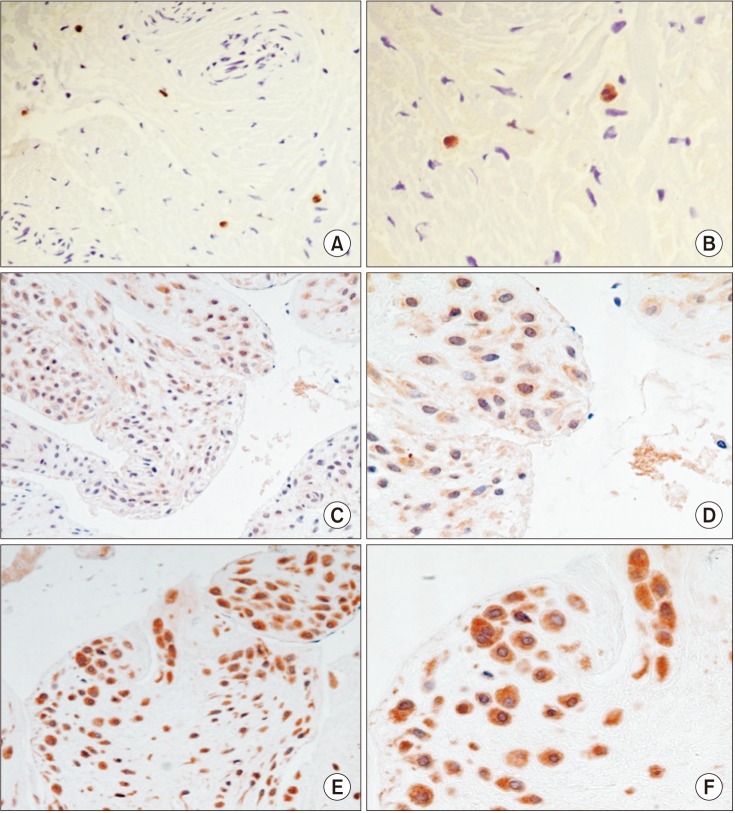1. Ishibashi H, Takenoshita Y, Ishibashi K, Oka M. Expression of extracellular matrix in human mandibular condyle. Oral Surg Oral Med Oral Pathol Oral Radiol Endod. 1996; 81:402–414. PMID:
8705585.

2. Kapila S, Lee C, Richards DW. Characterization and identification of proteinases and proteinase inhibitors synthesized by temporomandibular joint disc cells. J Dent Res. 1995; 74:1328–1336. PMID:
7629341.

3. Väätäinen U, Lohmander LS, Thonar E, Hongisto T, Agren U, Rönkkö S, et al. Markers of cartilage and synovial metabolism in joint fluid and serum of patients with chondromalacia of the patella. Osteoarthritis Cartilage. 1998; 6:115–124. PMID:
9692066.

4. Kubota E, Kubota T, Matsumoto J, Shibata T, Murakami KI. Synovial fluid cytokines and proteinases as markers of temporomandibular joint disease. J Oral Maxillofac Surg. 1998; 56:192–198. PMID:
9461144.

5. Imai K, Ohta S, Matsumoto T, Fujimoto N, Sato H, Seiki M, et al. Expression of membrane-type 1 matrix metalloproteinase and activation of progelatinase A in human osteoarthritic cartilage. Am J Pathol. 1997; 151:245–256. PMID:
9212749.
6. Imai S, Konttinen YT, Jumppanen M, Lindy O, Ceponis A, Kemppinen P, et al. High levels of expression of collagenase-3 (MMP-13) in pathological conditions associated with a foreign-body reaction. J Bone Joint Surg Br. 1998; 80:701–710. PMID:
9699841.

7. Kubota E, Imamura H, Kubota T, Shibata T, Murakami K. Interleukin 1 beta and stromelysin (MMP3) activity of synovial fluid as possible markers of osteoarthritis in the temporomandibular joint. J Oral Maxillofac Surg. 1997; 55:20–27. discussion 27-8. PMID:
8994464.
8. Tiilikainen P, Pirttiniemi P, Kainulainen T, Pernu H, Raustia A. MMP-3 and -8 expression is found in the condylar surface of temporomandibular joints with internal derangement. J Oral Pathol Med. 2005; 34:39–45. PMID:
15610405.

9. Huh JK, Kim HG, Ko JY. Magnetic resonance imaging of temporomandibular joint synovial fluid collection and disk morphology. Oral Surg Oral Med Oral Pathol Oral Radiol Endod. 2003; 95:665–671. PMID:
12789145.

10. McDonnell S, Morgan M, Lynch C. Role of matrix metalloproteinases in normal and disease processes. Biochem Soc Trans. 1999; 27:734–740. PMID:
10917674.

11. Mizui T, Ishimaru J, Miyamoto K, Kurita K. Matrix metalloproteinase-2 in synovial lavage fluid of patients with disorders of the temporomandibular joint. Br J Oral Maxillofac Surg. 2001; 39:310–314. PMID:
11437431.

12. Dioszegi M, Cannon P, Van Wart HE. Vertebrate collagenases. Methods Enzymol. 1995; 248:413–431. PMID:
7674935.
13. Jeffrey JJ. Interstitial collagenases. In : Parks WC, Mecham RP, editors. Matrix metalloproteinases. San Diego: Academic Press;1998.
14. Freije JM, Díez-Itza I, Balbín M, Sánchez LM, Blasco R, Tolivia J, et al. Molecular cloning and expression of collagenase-3, a novel human matrix metalloproteinase produced by breast carcinomas. J Biol Chem. 1994; 269:16766–16773. PMID:
8207000.

15. Reboul P, Pelletier JP, Tardif G, Cloutier JM, Martel-Pelletier J. The new collagenase, collagenase-3, is expressed and synthesized by human chondrocytes but not by synoviocytes. A role in osteoarthritis. J Clin Invest. 1996; 97:2011–2019. PMID:
8621789.

16. Mitchell PG, Magna HA, Reeves LM, Lopresti-Morrow LL, Yocum SA, Rosner PJ, et al. Cloning, expression, and type II collagenolytic activity of matrix metalloproteinase-13 from human osteoarthritic cartilage. J Clin Invest. 1996; 97:761–768. PMID:
8609233.

17. Hasty KA, Jeffrey JJ, Hibbs MS, Welgus HG. The collagen substrate specificity of human neutrophil collagenase. J Biol Chem. 1987; 262:10048–10052. PMID:
3038863.

18. Welgus HG, Jeffrey JJ, Eisen AZ. The collagen substrate specificity of human skin fibroblast collagenase. J Biol Chem. 1981; 256:9511–9515. PMID:
6270089.

19. Gepstein A, Shapiro S, Arbel G, Lahat N, Livne E. Expression of matrix metalloproteinases in articular cartilage of temporomandibular and knee joints of mice during growth, maturation, and aging. Arthritis Rheum. 2002; 46:3240–3250. PMID:
12483728.

20. Gepstein A, Arbel G, Blumenfeld I, Peled M, Livne E. Association of metalloproteinases, tissue inhibitors of matrix metalloproteinases, and proteoglycans with development, aging, and osteoarthritis processes in mouse temporomandibular joint. Histochem Cell Biol. 2003; 120:23–32. PMID:
12827373.

21. Huh JK, Park KK, Choi MA, Kim HG. Expression of matrix metalloproteinase-1 and -2 mRNA in retrodiscal tissue of the temporomandibular joint. J Korean Assoc Oral Maxillofac Surg. 2003; 29:212–218.
22. Ishimaru JI, Oguma Y, Goss AN. Matrix metalloproteinase and tissue inhibitor of metalloproteinase in serum and lavage synovial fluid of patients with temporomandibular joint disorders. Br J Oral Maxillofac Surg. 2000; 38:354–359. PMID:
10922168.

23. Leonardi R, Loreto C, Barbato E, Caltabiano R, Lombardo C, Musumeci G, et al. MMP-13 (collagenase 3) localization in human temporomandibular joint discs with internal derangement. Acta Histochem. 2008; 110:314–318. PMID:
18262231.

24. Marchetti C, Cornaglia I, Casasco A, Bernasconi G, Baciliero U, Stetler-Stevenson WG. Immunolocalization of gelatinase-A (matrix metalloproteinase-2) in damaged human temporomandibular joint discs. Arch Oral Biol. 1999; 44:297–304. PMID:
10348355.

25. Gomis-Rüth FX, Maskos K, Betz M, Bergner A, Huber R, Suzuki K, et al. Mechanism of inhibition of the human matrix metalloproteinase stromelysin-1 by TIMP-1. Nature. 1997; 389:77–81. PMID:
9288970.

26. Naito K, Takahashi M, Kushida K, Suzuki M, Ohishi T, Miura M, et al. Measurement of matrix metalloproteinases (MMPs) and tissue inhibitor of metalloproteinases-1 (TIMP-1) in patients with knee osteoarthritis: comparison with generalized osteoarthritis. Rheumatology (Oxford). 1999; 38:510–515. PMID:
10402070.

27. Wang YL, Li XJ, Qin RF, Lei DL, Liu YP, Wu GY, et al. Matrix metalloproteinase and its inhibitor in temporomandibular joint osteoarthrosis after indirect trauma in young goats. Br J Oral Maxillofac Surg. 2008; 46:192–197. PMID:
18164790.

28. Sawatsubashi M, Mizokami H, Tokunaga O, Shin T. Expression of MMP-1, TIMP-1, and type I collagen in laryngeal carcinoma. Mod Pathol. 1998; 11:878–885. PMID:
9758368.






 PDF
PDF ePub
ePub Citation
Citation Print
Print



 XML Download
XML Download